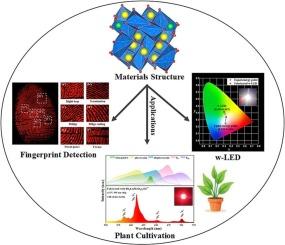新型红色荧光体Rb5La(MoO4)4:Eu3+用于植物栽培led、w- led和潜在指纹检测的光学特性和judd - felt分析
IF 4.7
3区 化学
Q2 CHEMISTRY, PHYSICAL
Journal of Photochemistry and Photobiology A-chemistry
Pub Date : 2025-09-11
DOI:10.1016/j.jphotochem.2025.116778
引用次数: 0
摘要
采用高温固相法制备了不同掺杂浓度(x = 0.05 ~ 1.00 mol)的红色发光Rb5La(MoO4)4:xEu3+荧光粉。通过x射线衍射(XRD)、扫描电镜(SEM)和光致发光光谱分析等综合表征,证明了其优异的性能。395 nm波长激发诱导了从5D0能级到7F1 (591 nm)、7F2 (616 nm)、7F3 (657 nm)和7F4 (707 nm)四个不同能级的辐射跃迁。通过发射光谱测定了Rb5La(MoO4)4:Eu3+荧光粉的Judd-Ofelt参数(Ω2, Ω4),证实了Eu3+在Rb5La(MoO4)4的晶格内占据不对称位置。发光强度在掺杂浓度为0.60 mol时达到最大,超过该浓度时,最近邻离子的相互作用导致浓度猝灭。值得注意的是,所有合成荧光粉的颜色纯度都超过99.8%。Rb5La(MoO4)4:0.60Eu3+的内量子产率为60.22%,活化能(Ea)为0.28 eV。所研制的红色发光LED器件与叶绿素b、藻蓝蛋白、光敏色素红PR等光合色素具有明显的光谱重叠,在红光(600 ~ 700 nm)波长范围内均可为植物提供补充光。用该荧光粉制备的白光发光二极管的相关色温(CCT)为5407 K,显色指数(CRI, Ra)为90。该荧光粉展示了指纹可视化能力,特别是在多色基材上解析I-III级脊细节方面。基于上述发现,Rb5La(MoO4)4:Eu3+荧光粉在植物栽培led、w- led和指纹检测等方面具有相当大的应用潜力。本文章由计算机程序翻译,如有差异,请以英文原文为准。

Optical characteristics and Judd–Ofelt analysis of novel red phosphors Rb5La(MoO4)4:Eu3+ for plant-cultivation LEDs, w-LEDs, and latent fingerprint detection
A range of red-emitting Rb5La(MoO4)4:xEu3+ phosphors with varying dopant concentrations (x = 0.05–1.00 mol) were prepared through high-temperature solid-state methods. Comprehensive characterization through X-ray diffraction (XRD), scanning electron microscopy (SEM), and photoluminescence spectroscopy analysis demonstrated its outstanding performance. Excitation at 395 nm wavelengths induced four distinct radiative transitions from the 5D0 level to 7F1 (591 nm), 7F2 (616 nm), 7F3 (657 nm), and 7F4 (707 nm) levels. The Judd-Ofelt parameters (Ω2, Ω4) of Rb5La(MoO4)4:Eu3+ phosphors were determined from the emission spectrum, confirming that Eu3+ occupies asymmetric positions within the crystal lattice of Rb5La(MoO4)4. The luminescence intensity reached its maximum at 0.60 mol doping concentration, beyond which the interaction of the nearest-neighbor ions led to concentration quenching. Notably, all synthesized phosphors demonstrated exceptional color purity exceeding 99.8 %. The Rb5La(MoO4)4:0.60Eu3+ is accompanied by an impressive internal quantum yield of 60.22 % and an activation energy (Ea) of 0.28 eV. The developed red-emission LED device showed remarkable spectral overlap with photosynthetic pigments such as chlorophyll b, phycocyanin, and phytochrome red PR, which can provide supplementary light for plants in both the red (600–700 nm) wavelength range. A white light-emitting (w-LED) diode constructed with this phosphor exhibited a correlated color temperature (CCT) of 5407 K and a color rendering index (CRI, Ra) value of 90. The phosphor demonstrates fingerprint visualization capabilities, particularly in resolving Level I–III ridge details on multicolor substrates. Based on the above findings, Rb5La(MoO4)4:Eu3+ phosphors hold considerable potential for applications in plant cultivation LEDs, w-LEDs, and fingerprint detection.
求助全文
通过发布文献求助,成功后即可免费获取论文全文。
去求助
来源期刊
CiteScore
7.90
自引率
7.00%
发文量
580
审稿时长
48 days
期刊介绍:
JPPA publishes the results of fundamental studies on all aspects of chemical phenomena induced by interactions between light and molecules/matter of all kinds.
All systems capable of being described at the molecular or integrated multimolecular level are appropriate for the journal. This includes all molecular chemical species as well as biomolecular, supramolecular, polymer and other macromolecular systems, as well as solid state photochemistry. In addition, the journal publishes studies of semiconductor and other photoactive organic and inorganic materials, photocatalysis (organic, inorganic, supramolecular and superconductor).
The scope includes condensed and gas phase photochemistry, as well as synchrotron radiation chemistry. A broad range of processes and techniques in photochemistry are covered such as light induced energy, electron and proton transfer; nonlinear photochemical behavior; mechanistic investigation of photochemical reactions and identification of the products of photochemical reactions; quantum yield determinations and measurements of rate constants for primary and secondary photochemical processes; steady-state and time-resolved emission, ultrafast spectroscopic methods, single molecule spectroscopy, time resolved X-ray diffraction, luminescence microscopy, and scattering spectroscopy applied to photochemistry. Papers in emerging and applied areas such as luminescent sensors, electroluminescence, solar energy conversion, atmospheric photochemistry, environmental remediation, and related photocatalytic chemistry are also welcome.

 求助内容:
求助内容: 应助结果提醒方式:
应助结果提醒方式:


